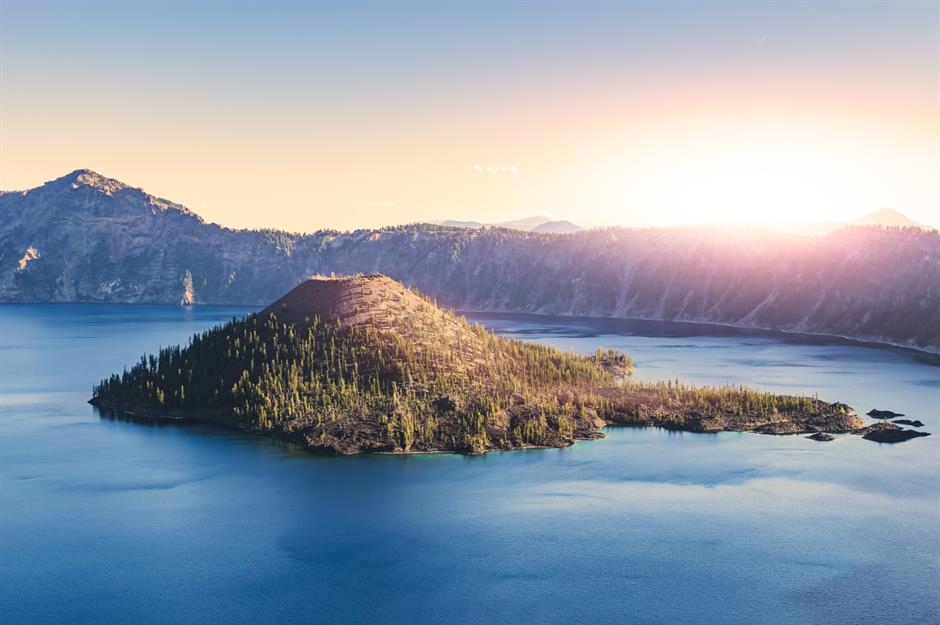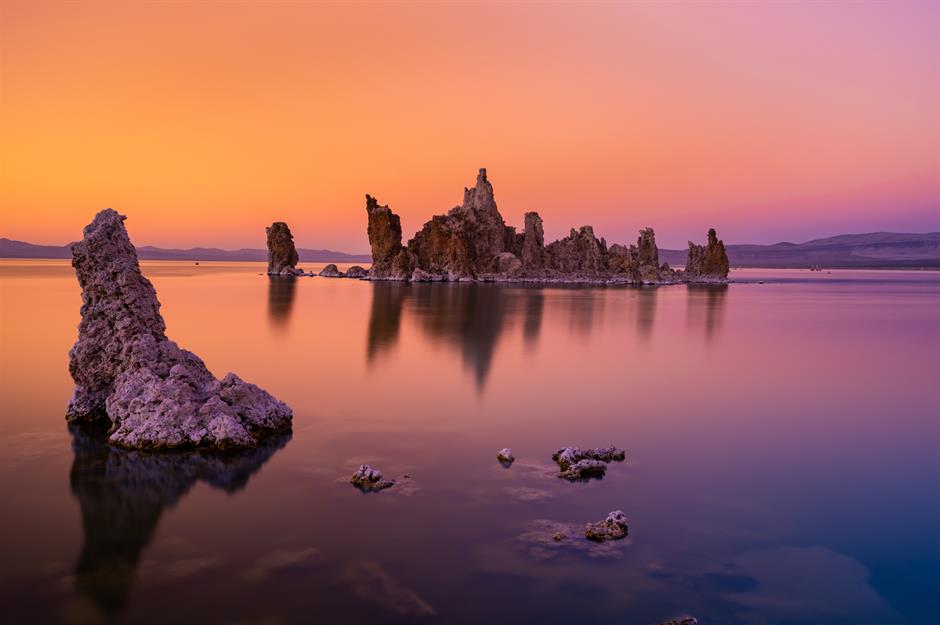America's most beautiful lakes in pictures
Watery wonders
The US has around 125,000 lakes in its lower 48 states alone, while Alaska blows that out of the water, claiming to have a whopping three million watery wonders. Join us for a virtual tour around America and feast your eyes on the country's most stunning lakes.
Mono Lake, California
Mono Lake, close to Yosemite National Park, is twice as salty as an ocean because it has no outlets. Covering 70 square miles (181sqkm), this so-called inland sea formed more than 760,000 years ago, yet its most striking features – the spindly limestone tufa towers – were exposed in the 1980s thanks to lowering water levels.
Mono Lake, California
You could scroll through photos of this natural beauty for hours. The snow-capped peaks of the Sierra Nevada mountains are mirrored in the water on clear days and there's wildlife aplenty. Waterfowl splash around and wild horses roam in nearby meadows.
Love this? Follow us on Facebook for travel inspiration and more
Yellowstone Lake, Wyoming
Vast Yellowstone Lake freezes completely in winter and thaws in late spring, but it’s strikingly beautiful at any time of year. Bordered by Yellowstone National Park's vivid geothermal springs, its shimmering surface conceals hidden depths...
Yellowstone Lake, Wyoming
Recent research has found that, if the lake were drained of water, it would reveal geysers, hot springs and canyons like those found around its edges and elsewhere in the park. There are many creatures that call Yellowstone home – bighorn lambs, bear cubs, elk calves and baby bison among others.
Lake Tahoe, California and Nevada
Lake Tahoe, a freshwater lake straddling the California and Nevada border, is mesmerising. Its clear blue waters sparkle against a backdrop of the Sierra Nevada Mountains. It's truly a sight to behold.
Lake Tahoe, California and Nevada
This stunner is among the world's 20 oldest lakes, at around two million years-old. The deepest point plunges to 1,645 feet (42m) – if the Empire State Building were submerged here, it wouldn't even break the surface. There are some magical goings-on too. Some say a prehistoric creature lives in the watery depths.
Avalanche Lake, Montana
Montana is drowning in beautiful bodies of water, with more than 3,000 lakes and reservoirs across the state. It’s hard to pick the prettiest but we reckon Avalanche Lake just edges into the lead.
Avalanche Lake, Montana
Located in Glacier National Park, the lake has crystalline, glacier-fed water, forested shores and the Rocky Mountains shimmer in the distance like the most striking wallpaper. In winter, it's prone to avalanches, hence the name.
Lady Bird Lake, Austin, Texas
Although more famous for its musical connections, Austin has a surprising amount of green spaces – and blue, for that matter. Lady Bird Lake is actually a reservoir whose skinny shape makes it look more like a river.
Lady Bird Lake, Austin, Texas
It was created in 1960 as a cooling pond for a power plant and was later renamed after former president Lyndon B Johnson’s wife, Claudia 'Lady Bird' Johnson. At nightfall, 1.5 million Mexican free-tailed bats flutter from beneath Congress Avenue Bridge (pictured) like ash in the breeze.
Lake Clark, Alaska
Alaska makes even Montana look a little dried-up. The northernmost state has around three million lakes which makes you wonder how there’s any dry land at all. Some are seasonal, fed by snowmelt and glaciers, while Lake Clark – part of Lake Clark National Preserve – is full year-round.
Lake Clark, Alaska
One of many lakes in the preserve, Lake Clark’s skinny, turquoise body stretches to around 50 miles (80km) in length and the limpid water is fed by waterfalls, rivers, streams and glaciers. Brown bears and bald eagles form part of the eco-system here.
Redfish Lake, Idaho
Redfish Lake, part of Sawtooth National Forest, is named for the huge quantities of sockeye salmon that used to arrive here after a 900-mile (1,448-km) migration from the Pacific Ocean. Although now the number has drastically dwindled. The water’s placid surface provides a flawless mirror for the Sawtooth Mountains.
Redfish Lake, Idaho
The 4.4-mile-long (7.2km) lake is surrounded by lush alpine forest and majestic mountains. It plunges to a maximum depth of 387 feet (118m) while sandy beaches fringe the shore of the lake’s shallower edges.
Lake Superior, Michigan
It’s hard to argue with the seemingly boastful name of Lake Superior. The biggest of the Great Lakes chain and the world’s largest freshwater lake by surface area (it covers 31,700 square miles/82,102sqkm), it feels more like an ocean.
Lake Superior, Michigan
The lake surrounds Isle Royale National Park, an archipelago of more than 200 islands – some of which have their own mini lakes, waterfalls and even shipwrecks. The largest, Isle Royale, has wildlife including wolves and moose.
Take a look at these photos of the world's most spectacular shipwrecks
Lake Powell, Utah and Arizona
Mother Nature is a pretty talented painter but man-made lakes can be equally gorgeous as their natural counterparts. None prove it quite so convincingly as Lake Powell, which straddles Utah and Arizona. Mind you, the reservoir’s appeal is rather boosted by its proximity to natural bridges, dams and canyons carved into red and apricot rock.
Lake Powell, Utah and Arizona
Its beauty hasn't gone unnoticed. The lake has featured in films such as the 1968 version of Planet of the Apes and Oscar-winning Gravity, released in 2013.
Diablo Lake, Washington
Many lakes are described as turquoise but Diablo Lake outdoes them all. Its vivid appearance is caused by flour-like particles ground from the rock of surrounding glaciers, and illuminated by sunlight. The result is breathtaking.
Diablo Lake, Washington
The lake is framed by snow-capped peaks and waterfalls. The forest that surrounds the lake is home to wildlife like black-tailed deer and hoary marmots, who whistle when they sense a predator is nearby.
Lake George, New York
Lake George is nicknamed the Queen of American Lakes and Thomas Jefferson, the USA’s third president, described it as “the most beautiful water I ever saw”. As this photo proves, the natural wonder, which glistens at the base of the Adirondack Mountains, lives up to the hype.
Lake George, New York
The idyllic body of water is renowned for its soothing clear expanse – all 45 square miles (116.5sqkm) of it. Lake George, which was formed some 10,000 years ago, is dotted with more than 150 islands.
Lake Jocassee, South Carolina
Lake Jocassee is another man-made beauty proving natural isn’t always best. This reservoir was created in 1973 and is fed by cool, clear water flowing from Appalachian mountain rivers. The shores are largely undeveloped with tucked-away coves, rocky outcrops and waterfalls.
Lake Jocassee, South Carolina
Jocassee literally means 'Place of the Lost One' in Cherokee which only adds to the romance of this beautiful spot. The 7,500-acre reservoir plunges to a maximum depth of around 300 feet (91m) and has a smattering of small islets.
Hanging Lake, Colorado
Waterfalls cascade into shimmering, spearmint-hued pools at Hanging Lake, located in Glenwood Canyon. The lake is so-named because it appears to hang from a cliff and its dramatic beauty more than makes up for its small size.
Hanging Lake, Colorado
This stunner was designated a National Natural Landmark in 2011. It's a unique example of a lake formed by travertine (a type of limestone) deposition. There's also one of the best and largest examples of a hanging garden plant community in the province.
Caddo Lake, Texas and Louisiana
This swampy lake straddles Texas and Louisiana, and it could hardly be more Southern in its feel and appearance. Spanish moss drips from cypress trees, whose broad, knotted trunks are submerged in the soupy water.
Take a look at these photos of the world's most beautiful trees
Caddo Lake, Texas and Louisiana
Alligators can be occasionally spotted basking on logs here, as well as herons, armadillos and turtles. The lake has an ethereal, slightly spooky beauty and some claim this is prime Bigfoot territory (people call him the 'Caddo critter').
Crater Lake, Oregon
America’s deepest lake (a staggering 1,943ft/592m) is often the most camera-shy. In winter, it can hidden in a wall of fog but if it clears, the blindingly blue water of this caldera basin is breathtaking.
Crater Lake, Oregon
The lake was formed more than 7,000 years ago and is a collapsed volcano filled with rain and snowmelt. The cinder cone-shaped Wizard Island which rises in its centre makes it even more distinctive.

